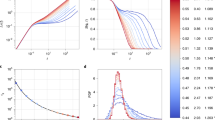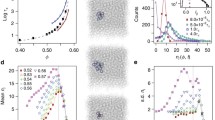Abstract
Physics Nobel Prize winner P.W. Anderson famously wrote in 1995: “The deepest and most interesting unsolved problem in solid state theory is probably the theory of the nature of the glass and the glass transition”. Despite much effort in the intervening years, the problem is still unsolved. We contribute a novel mathematical approach to this problem. The main new ingredient is finite dimension, a recently introduced “fractal” dimension defined only for finite sets. Our methods sharply distinguish the glass transition temperature and give hints as to the structural changes that occur in the transition.
Graphic Abstract









Similar content being viewed by others
Notes
This is no coincidence: while CS need not be a tree, it is shown in [17] that being a tree is the “general case” for CS.
References
K. Ngai, S. Capaccioli, N. Shinyashiki, J. Phys. Chem. B 112, 12 (2008)
S. Rzoska, V. Mazur, Soft Matter under Exogenic Impacts (Springer, Dordrecht, 2007)
C. Balbuena, R. Montani, M. Frechero, Physica A Stat. Mech. Appl. 432, 400–409 (2015)
J. Dyre, Rev. Modern Phys. 78, 3 (2006)
M. Micoulaut, J. Phillips, J. Non-Crystal. Solids 353, 18–21 (2007)
T. Tropin, J. Schmelzer, V. Aksenov, Physics-Uspekhi 59, 1 (2016)
E. Zanotto, J. Mauro, J. Non-Crystal. Solids 471, 490–495 (2017)
L. García, M. Molina, P. di Prátula, S. Terny, J. Castillo, D. Serna, M.A. Frechero, Mater. Sci. Eng. B 266, 115058 (2021)
J.M. Alonso, arXiv:1508.02946 e-prints (2015)
J.M. Alonso, arXiv:1607.08130v1 e-prints (2016)
K. Falconer, Fractal Geometry: Mathematical Foundations and Its Applications (John Wiley & Sons, Chichester, UK, 1990)
Y. Ida, Phys. Earth Planet. Inter. 13, 2 (1976)
J. Habasaki, I. Okada, Y. Hiwatari, Mole. Simul. 9(1), 49–63 (1992)
J. Habasaki, I. Okada, Y. Hiwatari, Mole. Simul. 10(1), 19–26 (1993)
J. Habasaki, Y. Hiwatari, Phys. Rev. E 65, 2 (2002)
S. Plimpton, J. Comput. Phys. 117, 1 (1995)
J.M. Alonso, arXiv: 2103.16471 e-prints (2021)
L. Vietoris, Mathematische Annalen 97, 1 (1927)
G. Van Rossum, F.L. Drake, Python 3 Reference Manual (CreateSpace, Scotts Valley, CA, 2009)
R. Karp, Reducibility among combinatorial problems, in Complexity of Computer Computations. ed. by R.E. Miller, J.W. Thatcher, J.D. Bohlinger (The IBM Research Symposia Series. Springer, Boston, MA, 1972)
SageMath, the Sage Mathematics Software System (Version sage–8.3–OSX\_10.11.6), The Sage Developers, https://www.sagemath.org (2018)
J.M. Alonso, A. Arroyuelo, P. Garay, O. Martin, J. Vila, Sci. Rep. 8, 1 (2018)
Pandas (version 1.1.5), The pandas development team, 2020, https://doi.org/10.5281/zenodo.3509134 (2020)
J. Schmelzer, I. Gutzow, O. Mazurin, Glasses and the glass transition Wiley-VCH Verlag, Weinheim (2011)
Acknowledgements
This work has been possible to the financing support by Universidad Nacional del Sur (PGI 24/Q112), PICT 2016-0101 (plan Argentina Innovadora 2020) Agencia Nacional de Promoción Científica y Tecnológica (ANPCyT) and Universidad Tecnológica Nacional, Facultad Regional San Rafael, under projects PID UTN 8104 TC and 5154 TC. M.A.F and F.O.S.V are Researcher Fellow of the CONICET Argentina.
Author information
Authors and Affiliations
Contributions
All the authors were involved in the preparation of the manuscript. All the authors have read and approved the final manuscript.
Corresponding author
Appendices
Appendix A
The first term in Eq. 1 is the Coulomb interaction with the effective charge numbers \(q_{i}\); the second term is a dispersive interaction and it presents those involving only oxygen ions; and the last term is a Born–Meyer type potential that takes into account the repulsive short-range interactions.
The system was first equilibrated at 3500 K in a 2 ns run using the microcanonical ensemble (NVE). Then, to reach the working temperature, it was cooled down from 3500 K until it reached both the target temperature and the normal pressure, in 2 successive cooling steps, one of cooling followed by a stabilization. Each cooling step consisted of a 2 ns run using a thermostat to decrease the temperature linearly in the NPT ensemble

Once the temperature was reached, a period of a 2 ns equilibration in the NPT was applied to verify no temperature drift and minimize the typical pressure oscillations in solids.
Appendix B
This appendix contains excerpts from [17], detailing the definition of the Connected Sparse Graph CSG(M), simplified to CS. See Fig. 2 for a 2-dimensional illustration of the definition. We let \({\mathbb {R}}_{>0}\) denote the set of positive real numbers.
Recall that two vertices belong to the same connected component (or simply, component) if there is a path joining them. The definition is inductive: starting with M, new edges are added at each step, obtaining an increasing sequence of graphs:
STEP 0. \(S_0\) is a graph with no edges, \(V(S_0)=M\), and \(E(S_0)=\emptyset \). The set of components of \(S_0\) is \(K_0 =\{\{x\}| x \in M\}\), which we identify with M by setting \(d(\{x\},\{y\}){:}{=}d(x,y)\). Thus, \(S_0\) has \(|K_0|=|M|\) components.
STEP 1. The function \(\nu _0:M\rightarrow {\mathbb {R}}_{>0}\), defined by
gives the distance to the nearest neighbours of a point. Note that we can consider \(\nu _0\) as a function defined on \(K_0\), by setting \(\nu _0(\{x\}){:}{=} \nu _0(x)\). Let
That is, for every vertex x, we add an edge connecting x to each one of its nearest neighbours. Clearly, \(S_0\subset S_1\).
The graph \(S_1\) is not connected in general. Let \(K_1\) denote the set of its components. If \(|K_1|=1\), we stop here and define \(CSG(M){:}{=} S_1\). If \(|K_1|>1\), we proceed to Step 2. Note that \(|K_1|\le |M|/2\), since every \(x \in M\) has a nearest neighbour.
STEP \(i+1\). In this inductive step, we assume the graphs \(S_0\subset S_1 \subset \cdots \subset S_{i}\) are constructed, that \(K_{i}\) is the set of connected components of \(S_{i}\) and that \(1<|K_{i}| \le |M|/2^{i}\).
Let \(k,k'\in K_{i}\) be distinct components. The function \(\nu _{i}: K_{i} \rightarrow {\mathbb {R}}_{>0}\) , defined by
gives the distance from k to its nearest components. For \(x\in M\), we let \([x]_i\) denote the component of x in \(S_i\). Let
and define \(E(S_{i+1}){:}{=}E(S_{i}) \cup B(S_{i+1})\). Clearly, \(S_{i}\subset S_{i+1}\).
Let \(K_{i+1}\) denote the set of components of \(S_{i+1}\). If \(|K_{i+1}|=1\), we stop here and define \(CSG(M){:}{=} S_{i+1}\). If \(|K_{i+1}|>1\), we proceed to Step \({i+2}\). Note that \(|K_{i+1}|\le |K_{i}|/2\), since every \(k \in K_{i}\) has a nearest connected component. Hence, \(|K_{i+1}|\le |M|/2^{i+1}\).
Since |M| is finite, after a finite number of steps we obtain a connected graph, and this we define to be CSG(M). Also, note that no choices are made at any step, so that CSG(M) is uniquely defined.
Rights and permissions
About this article
Cite this article
Alonso, J.M., Sanchez-Varretti, F.O. & Frechero, M.A. Finite dimension unravels the structural features at the glass transition. Eur. Phys. J. E 44, 88 (2021). https://doi.org/10.1140/epje/s10189-021-00098-7
Received:
Accepted:
Published:
DOI: https://doi.org/10.1140/epje/s10189-021-00098-7




